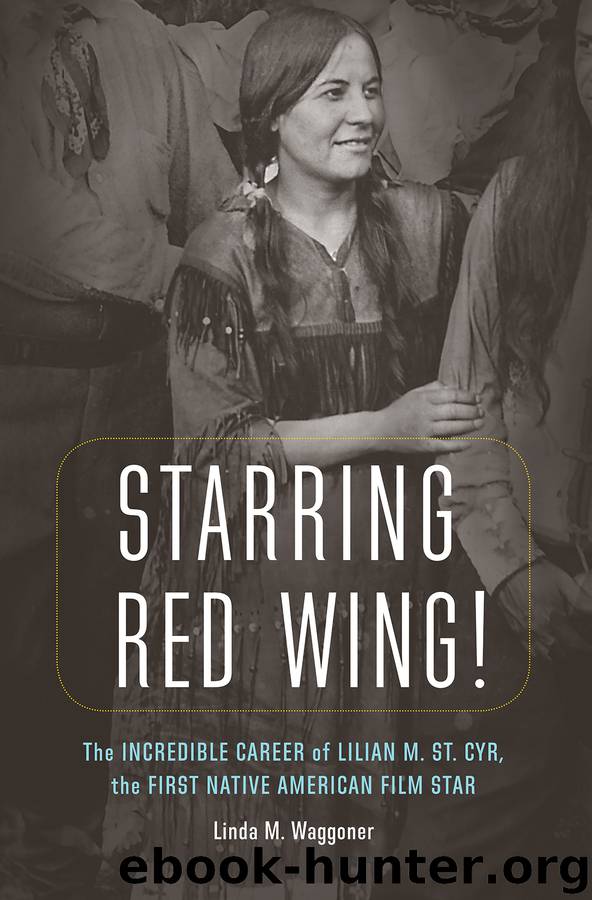Starring Red Wing! by Linda M. Waggoner

Author:Linda M. Waggoner
Language: eng
Format: epub
Tags: BIO028000 Biography & Autobiography / Native Americans, BIO002000 Biography & Autobiography / Cultural Heritage, BIO005000 Biography & Autobiography / Entertainment & Performing Arts, BIO022000 Biography & Autobiography / Women
Publisher: UNP - Bison Books
Farnum delivered the six-reel epic to the home office in New York, where Blaisdell interviewed him. “In nine weeks we have located grounds, engaged actors and built a studio, carpenter shop and scene dock,” he recounted. “Just bear in mind we had twenty-one days of rain. I never saw such a conglomeration of weather in my life.” Then he showed Blaisdell “a five-foot panoramic view of the coast studio with the players lined up in front”—now a well-known image of the first day of shooting at the barn. Red Wing in costume standing midphoto holds Carmen DeRue’s hand. Farnum pointed out three men in the photograph, “a champion roper,” “a champion rider,” and “a six feet five inch tall Texan,” who especially impressed him. Art Accord was certainly one of the three, as was, perhaps, Milt Brown. Farnum had found, to his delight, that all of the cowboys in the cast, though rough-and-tumble, had gentle souls. Yet, he added, he was most fascinated by “the Indians” and enjoyed studying their ways.38
When the conversation turned to the theme of The Squaw Man, “the inter-marriage of the white and the Indian,” Farnum became thoughtful. “You know,” he said, “the minute a man marries a squaw he is taboo.” Still, he believed the “extenuating circumstances” shown by the film’s dramatic portrayal “creates such a situation that no man with a heart in him can fail to forgive.” These circumstances had everything to do with Red Wing’s portrayal of the Indian maid saving the white man, a role she had honed over six years. The white man’s transgression (getting her pregnant) can be forgiven, but, ironically, the Indian female’s sexual availability and race (inextricably bound) can only be exonerated through her death. DeMille’s film set this specifically American western narrative in stone with its trajectory that insures a happy ending for the white man—or at least America—but not ever for his Indian lover.39
On February 17 Lasky and Goldfish invited exhibitors and other trade people to a private showing at Broadway’s Long Acre Theater on 48th Street in New York.40 “The story is told in six parts and 264 scenes and is genuinely good,” wrote an attendee.41 The attendee felt the audience enjoyed Dustin Farnum’s performance, as well as his supporting cast. He also complimented the cinematography, particularly the exterior shots. He concluded that the public would like the film as much as they had the play.
“D,” the more erudite critic of the New York Dramatic Mirror, attended the preview and mused on his genuine surprise: “You [Lasky] jump into a game that many hard-working men have been studying for the past twenty years, and the very first time up to bat you pound out a home run.” He found that the motion picture kept the audience’s interest more than most, though he didn’t think Singleton was suited for his role. Still, he found little else to criticize. He believed the film captured Farnum’s “earnest acting . . . virile personality and powerful physique” just as well as the stage play had.
Download
This site does not store any files on its server. We only index and link to content provided by other sites. Please contact the content providers to delete copyright contents if any and email us, we'll remove relevant links or contents immediately.
| Crime & Criminals | LGBT |
| Special Needs | Women |
We're Going to Need More Wine by Gabrielle Union(18996)
Pimp by Iceberg Slim(14430)
Bombshells: Glamour Girls of a Lifetime by Sullivan Steve(14016)
The Radium Girls by Kate Moore(11964)
Becoming by Michelle Obama(9963)
Educated by Tara Westover(7989)
The Girl Without a Voice by Casey Watson(7841)
Wiseguy by Nicholas Pileggi(5699)
The Wind in My Hair by Masih Alinejad(5054)
Hitman by Howie Carr(5038)
The Rules Do Not Apply by Ariel Levy(4904)
Hunger by Roxane Gay(4889)
On the Front Line with the Women Who Fight Back by Stacey Dooley(4837)
Year of Yes by Shonda Rhimes(4721)
The Borden Murders by Sarah Miller(4268)
Papillon (English) by Henri Charrière(4220)
Joan of Arc by Mary Gordon(4049)
American Kingpin by Nick Bilton(3808)
Patti Smith by Just Kids(3746)
